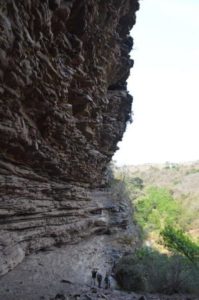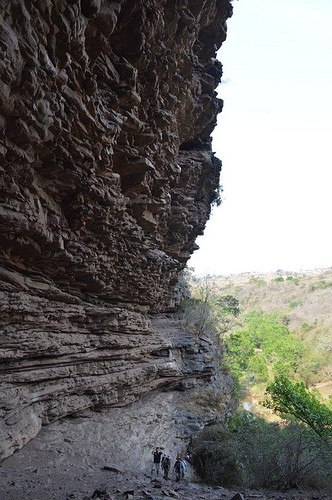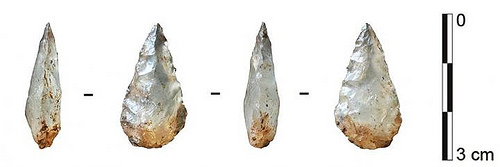
PLOS—Innovations in stone knapping technology during the South African Middle Stone Age enabled the creation of early projectile weapons, according to a study* published April 26, 2017 in the open-access journal PLOS ONE by Veerle Rots from University of Liège, Belgium, and colleagues.
The South African Middle Stone Age (MSA) is considered a period of major technological advancement, with hunter-gatherers introducing new manipulative techniques using heat and pressure to create stone projectile weapons. However, the timing and location of these developments is a topic of much debate.
The authors of the present study examined 25 weapon point fragments excavated from the Sibudu Cave site, analyzing their technological and functional differences and comparing them with reference samples produced for the purpose by an experienced knapper. Some of the points had two faces, a likely result of applying pressure to both sides. Some had serrations, or jagged edges, that were likely produced by a technique known as pressure flaking.
The researchers found that 14 of the 25 point fragments bore evidence of impact-related damage, animal residues, and wear features that strongly indicated that these points may have been used for hunting. Examination of the impact-related fractures and the distribution of the points indicated that these points may have been attached to handles to form projectile weapons and that these weapons were projected from a distance, most likely with a flexible spear-thrower or a bow.
____________________________________
Sibudu Cave is a rock shelter in a sandstone cliff in northern KwaZulu-Natal, South Africa. It is an important Middle Stone Age site occupied, with some gaps, from 77,000 years ago to 38,000 years ago. Text and image credit: DarkaRolandStark, Wikimedia Commons
_______________________________________________
Analyzed serrated pieces from Sibudu Cave. Credit: Rots et al (2017)
___________________________________
While further research would help to confirm the timeline and development of stone knapping techniques, the new Sibudu Cave site data may push back the evidence for the use of pressure flaking during the MSA to 77,000 years ago. The authors note that these findings highlight the diversity of technical innovations adopted by southern African MSA humans.
Article Source: PLOS ONE news release
_______________________________________________
*Rots V, Lentfer C, Schmid VC, Porraz G, Conard NJ (2017) Pressure flaking to serrate bifacial points for the hunt during the MIS5 at Sibudu Cave (South Africa). PLoS ONE 12(4): e0175151. doi:10.1371/journal.pone.0175151
_______________________________________________
Subscribe to Popular Archaeology Premium. Available on all laptops and mobile devices, and still the industry’s best value at only $9.00 annually.
___________________________________________
Travel and learn with Far Horizons.
____________________________________________
This richly illustrated issue includes the following stories: Recent findings shedding new light on the whereabouts of the remains of Philip of Macedon, father of Alexander the Great; how an archaeologist-sculptor is bringing bones of the dead back to life; archaeologists uncovering town life at the dawn of civilization; an exclusive interview with internationally acclaimed archaeologist James M. Adovasio about what makes the Meadowcroft Rockshelter prominent in the ongoing search for the first Americans; what archaeologists are finding at the site of the ancient city of Gath, the home town of the biblical Philistine giant, Goliath; and how scientists are redrawing the picture of human evolution in Europe. Find it on Amazon.com.









